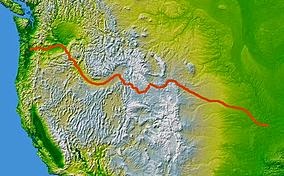The first major wagon train carrying 1,000 pioneers to the northwest departs from Elm Grove, Missouri, on the Oregon Trail. This trek has been dubbed "The Great Migration of 1843" or the "Wagon Train of 1843".
The date: May 22, 1843
The Journey: Over 2,000 miles
The Oregon Trail was much more than a pathway to the state of Oregon; it was the only practical corridor to the entire western United States. The places we now know as Washington, Oregon, California, Nevada, Idaho and Utah would probably not be a part of the United States today were it not for the Oregon Trail. That's because the Trail was the only feasible way for settlers to get across the mountains.
Source: The Oregon Trail
 |
| The route of the Oregon Trail shown on a map of the western United
States from Independence, Missouri (on the eastern end) to Oregon City, Oregon (on the western end) |
Leaving from Missouri, the most popular
"jumping off" point for settlers heading west, the journey will take usually five to six months...not by car, rail, or plane but simply covered wagon! As with any trip, there are many things to consider before the journey in preparation, during the journey to just simply stay alive and at the end of the journey as continued hardships are faced with a new life ahead.
As preparations are being made, it must be clearly understood from the moment the decision is made to "Go West, young man, go West" that a family's 'belongings' must fit into just one wagon.
 |
The typical box of a prairie schooner, the sides of which were lower than those of the Conestoga, was about 4 feet (1.2 metres) wide, 9 to 11 feet (2.7 to 3.4 metres) long, and 2 to 3 feet (0.6 to 0.9 metre) deep. With the bonnet, the wagon stood about 10 feet (3 metres) tall, and the total length of the wagon from front tongue and yoke to rear measured some 23 feet (7 metres). The box sat on two sets of wheels of different sizes: the rear wheels were about 50 inches (125 cm) in diameter, and the front wheels (made smaller to facilitate turning) were about 44 inches (112 cm). The wheels were made of wood, with iron bands fastened to the outside of the rims; at times, when the wood would shrink, these “tires” would separate from the rim.
Source: Encyclopædia Britannica, Inc.
During the journey, "Lightening the load" was important in order to maintain the health and strength of the animals pulling the wagons. Sometimes, travelers were forced to make difficult decisions and discard furniture or other items in order to lighten the load enough for the wagon to travel safely uphill over mountain passes.
Source: The Wagon Train
RE-LIVE THIS UNIQUE VIDEO OF THE OLD WEST AS BRAVE PIONEERS TRAVELED ACROSS AMERICA ONLY WITH A SONG AND A PRAYER BACK IN THE 1800'S.




No comments:
Post a Comment